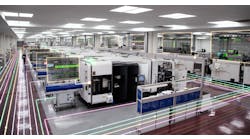Orders for new robotics systems in North America fell 25% in 2009, though the rate of decline slowed in the fourth quarter. The results are reported in annual statistics released by the Robotic Industries Association (RIA), a trade group.
The total number of robots delivered by North American suppliers in 2009 was 9,451, representing a value of $569.2 million. The RIA said the number of units delivered fell 25% versus 2008, and the dollar value of those deliveries fell 36% compared to the full-year 2008 results.
However, in the fourth quarter, deliveries of robots virtually stopped: RIA said the number of units delivered was nearly unchanged from the fourth quarter of 2008, and that revenues fell only 5% during the final quarter of 2009 compared to 4Q 2009.
“We hope that the stabilization we saw in the fourth quarter is a sign that the worst is behind us now,” stated RIA statistics committee chairperson, Tammy Mulcahy of ABB Robotics.
RIA represents more than 225 companies, including robot manufacturers, component suppliers, system integrators, end users, research groups and consulting firms. The group estimates that there are now about 194,000 robots in use in the U.S., making it the second-largest market for robotic placement, after Japan.RIA said the overall decline in industrial demand for robotic systems obscured real strength in some market segments. The number of robot units for robotics equipment from the life sciences/pharmaceutical/biomedical sector rose 43%. Orders for new robot units from the food and consumer goods sectors orders rose seven percent during the year past, according to RIA.
“While these are relatively small segments of the market, it’s very encouraging to see strong growth here despite the weak overall numbers,” stated RIA president Jeffrey A. Burnstein.
Orders for robotic systems placed by automotive OEMs increased 5% in 2009, but orders from automotive suppliers fell 49%. “The tier suppliers have suffered enormously during the painful restructuring of the automotive industry, which has had a noticeable impact on their investments in capital equipment,” Burnstein noted.





